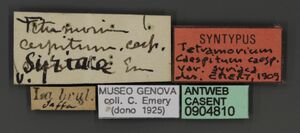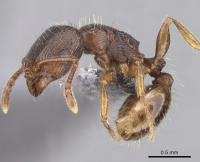Tetramorium syriacum
| Tetramorium syriacum | |
|---|---|

| |
| Scientific classification | |
| Kingdom: | Animalia |
| Phylum: | Arthropoda |
| Class: | Insecta |
| Order: | Hymenoptera |
| Family: | Formicidae |
| Subfamily: | Myrmicinae |
| Tribe: | Crematogastrini |
| Genus: | Tetramorium |
| Species: | T. syriacum |
| Binomial name | |
| Tetramorium syriacum Emery, 1924 | |
The meager biological information known about this species is taken from specimen labels: collected from a date farm and roadside desert, and foragers found on the ground.
Identification
Csösz, Radchenko and Schulz (2007) - T. syriacum workers differ from related species by the extremely wide frons, FR/CS 0.50 [0.49, 0.55].
Keys including this Species
- Key to Arabian Tetramorium
- Key to Tetramorium chefketi species-complex workers
- Key to Tetramorium chefketi species-complex queens
Distribution
Latitudinal Distribution Pattern
Latitudinal Range: 33.133333° to 21.133333°.
| North Temperate |
North Subtropical |
Tropical | South Subtropical |
South Temperate |
- Source: AntMaps
Distribution based on Regional Taxon Lists
Afrotropical Region: Saudi Arabia.
Palaearctic Region: Georgia, Israel, Syria (type locality), Türkiye.
Distribution based on AntMaps
Distribution based on AntWeb specimens
Check data from AntWeb
Countries Occupied
| Number of countries occupied by this species based on AntWiki Regional Taxon Lists. In general, fewer countries occupied indicates a narrower range, while more countries indicates a more widespread species. |

|
Estimated Abundance
| Relative abundance based on number of AntMaps records per species (this species within the purple bar). Fewer records (to the left) indicates a less abundant/encountered species while more records (to the right) indicates more abundant/encountered species. |

|
Biology
Castes
Known only from the worker caste.
Images from AntWeb
   
| |
| Syntype of Tetramorium syriacum. Worker. Specimen code casent0904810. Photographer Will Ericson, uploaded by California Academy of Sciences. | Owned by MSNG, Genoa, Italy. |
Nomenclature
The following information is derived from Barry Bolton's Online Catalogue of the Ants of the World.
- syriacum. Tetramorium caespitum var. syriaca Emery, 1924d: 277 (w.) SYRIA. [First available use of Tetramorium caespitum subsp. caespitum var. syriaca Emery, 1909d: 702; unavailable name.] Subspecies of caespitum: Emery, 1925c: 179; of semilaeve: Santschi, 1934d: 279. Raised to species: Collingwood, 1985: 265. See also: Csösz, Radchenko & Schulz, 2007: 34.
Unless otherwise noted the text for the remainder of this section is reported from the publication that includes the original description.
Description
Worker
Csösz, Radchenko and Schulz (2007) - Holotype: CL: 850; CW: 835; FR: 460; FL: 470; SL: 615; ML: 940; MW: 560; PEW: 260; PEH: 285; NOH: 165; NOL: 215; PEL : 190; PPW: 290; PPL: 210; PPH: 270; SPL: 125; SPSP: 205; EL: 145; EH: 110; ED: 215.
Figs 68–71. Large size, CS 832 [807, 865]. Whole body and appendages dark brown to black. Head slightly longer than broad, CL/CW 1.02 [0.99, 1.04], with slightly convex sides, straight occipital margin and rounded occipital corners. Eyes relatively small, EYE 0.162 [0.155, 0.171]. Frons very wide, FR/CS 0.50 [0.49, 0.55], frontal lobes as wide as frons, or slightly wider FL/FR 1.01 [1.00, 1.02]. Scape short, SL/CS 0.75 [0.70, 0.77], with short dorsal carina basally, strong parallel costulae extending scape. Promesonotal dorsum convex, metanotal groove shallow, but visible. Propodeal teeth long. Petiolar node cubic in profile, NOH/NOL 0.84 [0.78, 0.89], petiole relatively low, PEH/NOL 1.51 [1.43, 1.60]. General appearance coarsely rugose, ground surface microreticulate, dull. Head dorsum longitudinally rugose and microreticulate, occiput and sides rugoso-reticulate and microreticulate. Alitrunk dorsum rugoso-reticulate and coarsely microreticulate. Mesopleuron usually microreticulate. Dorsum of petiolar node rugoso-reticulate and microreticulate, dorsum of postpetiole longitudinally rugulose and microreticulate. Polygonal striation continuous on 1st gastral tergite, posteriorly disrupted. Basal part of first gastral tergite microreticulate (see fig. 7.), MRG 181.7 ±26.4 [150, 230]. Ventral surface of head with several short and few moderately long, straight, or few “C”-shape setae arising posterior to buccal cavity (see fig. 5.).
Type Material
Csösz, Radchenko and Schulz (2007) - Holotype worker: I. a. Brul., “Jaffa” [now Tel Aviv, ISRAEL], “Tetramorium”, “caespitum. caesp.”, “v. syriaca Em” [Emery’s handwriting] (1 worker; Museo Civico di Storia Naturale, Genoa)
References
- Borowiec, L. 2014. Catalogue of ants of Europe, the Mediterranean Basin and adjacent regions (Hymenoptera: Formicidae). Genus (Wroclaw) 25(1-2): 1-340.
- Collingwood, C. A. 1985. Hymenoptera: Fam. Formicidae of Saudi Arabia. Fauna Saudi Arab. 7: 230-302 (page 265, Raised to species)
- Csosz S., A. Radchenko and A. Schulz. 2007. Taxonomic revision of the Palaearctic Tetramorium chefketi species complex (Hymenoptera: Formicidae). Zootaxa. 1405:1-38.
- Emery, C. 1924f [1922]. Hymenoptera. Fam. Formicidae. Subfam. Myrmicinae. [concl.]. Genera Insectorum 174C: 207-397 (page 277, worker described)
- Emery, C. 1925d. Hymenoptera. Fam. Formicidae. Subfam. Formicinae. Genera Insectorum 183: 1-302 (page 179, Subspecies of caespitum)
- Kiran, K., Karaman, C. 2020. Additions to the ant fauna of Turkey (Hymenoptera, Formicidae). Zoosystema 42(18), 285-329 (doi:10.5252/zoosystema2020v42a18).
- Santschi, F. 1934d. Fourmis d'une croisière. Bull. Ann. Soc. Entomol. Belg. 74: 273-282 (page 279, Subspecies of semilaeve)
References based on Global Ant Biodiversity Informatics
- Borowiec L. 2014. Catalogue of ants of Europe, the Mediterranean Basin and adjacent regions (Hymenoptera: Formicidae). Genus (Wroclaw) 25(1-2): 1-340.
- Csősz S., A. Radchenko, and A. Schulz. 2007. Taxonomic revision of the Palaearctic Tetramorium chefketi species complex (Hymenoptera: Formicidae). Zootaxa 1405: 1-38.
- Gratiashvili N., Barjadze S. 2008. Checklist of the ants (Formicidae Latreille, 1809) of Georgia. Proceedings of the Institute of Zoology (Tbilisi) 23: 130-146.
- López, F. "Estudio morfológico y taxonómico de los grupos de especies ibéricas del género Tetramorium Mayr, 1855." Boletín de la Asociación Española de Entomología 15 (1991): 29-52.
- Vonshak M., and A. Ionescu-Hirsch. 2009. A checklist of the ants of Israel (Hymenoptera: Formicidae). Israel Journal of Entomology 39: 33-55.


